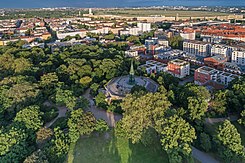Viktoriapark
| Viktoriapark | |
|---|---|
| Park in Berlin | |

|
|
| Aerial view of the park with the national monument | |
| Basic data | |
| place | Berlin |
| District | Kreuzberg |
| Created | 1880s |
| Newly designed | In the 1910s based on plans by Albert Brodersen . |
| Surrounding streets |
Kreuzbergstrasse (north) , Mehringdamm / Methfesselstrasse (east) , Sixtusgarten (south) , Katzbachstrasse (west) |
| Buildings | National Monument to the Wars of Liberation , artificial waterfall |
| use | |
| User groups | Foot traffic ; Leisure , events |
| Park design | based on plans by Hermann Mächtig |
| Technical specifications | |
| Parking area | 128,000 m² |
The Victoria Park is a green area of 12.8 hectares area on the Kreuzberg , the highest natural elevation of the Berlin city center. It is located in the district of Kreuzberg the district of Friedrichshain-Kreuzberg .
history
The prehistory of Viktoriapark began in 1821 with the inauguration of the national monument for the victories in the Wars of Liberation (1813-1815) against Napoleon Bonaparte . The design comes from Karl Friedrich Schinkel (1781–1841). The monument is shaped like the tower of a Gothic cathedral on a stepped, octagonal base. It stands on the highest point of a hill, which up until that time was known as the Tempelhofer Berg or the Runder Weinberg . The cross on the spire gave the mountain and later the administrative district its name. Schinkel had already planned to appropriately design the then sandy, largely barren area surrounding the monument. However, that only happened around 70 years later. Between 1888 and 1894 a park was built according to plans by the city gardening director Hermann Mächtig . In the years 1913–1916, the gardening director Albert Brodersen had the complex significantly expanded to the west.
In World War II the Victoria Park suffered significant damage. After these were finally resolved, the park was the first Berlin green space to be completely listed as a historical monument in 1980 .
Park, waterfall and memorial


The Kreuzberg reaches a height of 66 meters above sea level . At this point it marks the transition from the Berlin glacial valley to the geological plateau of the Teltow to the south . A park with the characteristics of a mountainous landscape was created on its northern slope below the monument. The terrain is steep and therefore required a dense network of paths. Further essential design elements in this part of the park are the rocky Wolfsschlucht with smaller water points and above all the large, artificially created waterfall as part of a visual axis from Großbeerenstraße to the monument on the top of the Kreuzberg. From there, a broad view over the inner city area is possible. The later enlargement of the park to the west concerned a rather gentle, hilly terrain. It was designed as a landscape park with extensive lawns. In this area there is now also an extensive children's playground, an animal enclosure, a sports field and a large beer garden at the Dudenstrasse park entrance .
Alongside the national monument, the waterfall is the most famous attraction in Viktoriapark. In 1891 the city council approved the building. After that, a natural complex made of granite and limestone was built with trees on the side. In order to operate the waterfall, the water has to be pumped up to the Kreuzberg. The difference in altitude is 24 meters and 13,000 liters per minute are moved. On October 14, 1893, the system was first publicly tested in a festive setting.
At the base of the falls a irregular shaped pond was created, on whose banks since 1896 the bronze sculpture The rare catch of Ernst Herter is; her motive: a mermaid got caught in a fisherman's net. Various similar landscape structures in the Giant Mountains , which at the time were a popular travel destination for wealthy Berliners, are assumed to be models for the design of the Kreuzberg waterfall . The website of the Berlin city administration mentions the Zackelfall (Wodospad Kamieńczyka) in the Polish part of the Giant Mountains, but there is no unequivocally documented model.
In May 2005 the We have faces memorial was erected in Viktoriapark to commemorate all women who were victims of rape. At the site of the memorial, a woman was attacked and raped by two men in 2002. The statue is part of the “We have faces” campaign.
To the southwest of the park is the Willy-Kressmann-Stadion (Katzbachstadion until 2010), a football stadium with an athletics facility.
literature
- Rike Fischer: At the summit of Berlin - a walk through the Viktoriapark in Kreuzberg. District Museum Friedrichshain-Kreuzberg, Berlin 2007, ISBN 978-3-935810-07-5 .
- Rainer Stürmer: The Viktoria Park - Portrait of a Berlin Volksgarten. In: The garden art . No. 3, 1991, pp. 118-130.
- Folkwin Wendland: Berlin's gardens and parks from the founding of the city to the end of the nineteenth century. (= Classic Berlin ). Propylaeen, Berlin 1979, ISBN 3-549-06645-7 , pp. 197-200.
- Clemens Alexander Wimmer: Parks and Gardens in Berlin and Potsdam. Published by the Senator for Urban Development and Environmental Protection, Section III - Garden Monument Preservation. 3. Edition. Nicolaische Verlagsbuchhandlung, Berlin 1989, ISBN 3-87584-267-7 , pp. 42-44.
Web links
- Information from urban development Berlin
- Entry in the Berlin State Monument List
- Video from Viktoriapark Berlin Street View
Individual evidence
- ↑ a b Viktoriapark waterfalls. Senate Department for Urban Development Berlin.
- ↑ Viktoriapark. Monument database of the Berlin State Monuments Office.
- ↑ Hilde Meier: We have faces. ( Memento from June 30, 2015 in the web archive archive.today ) In: Kultura-Extra online magazine. June 13, 2005.
Coordinates: 52 ° 29 ′ 20 ″ N , 13 ° 22 ′ 50 ″ E